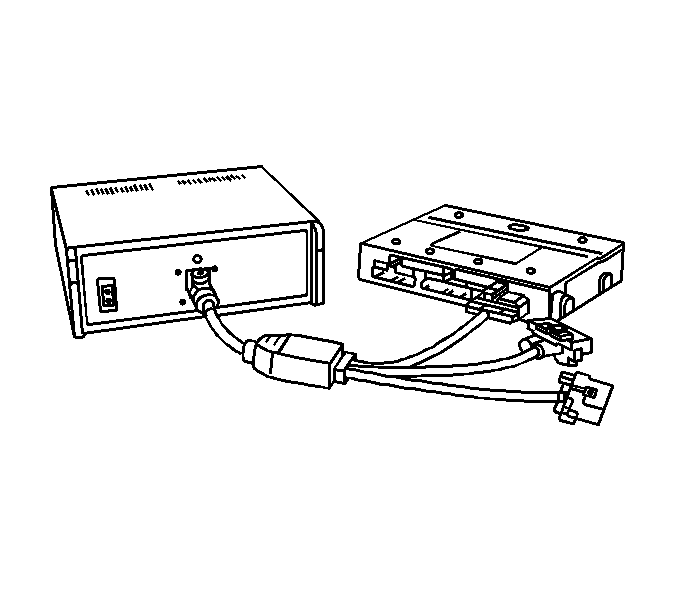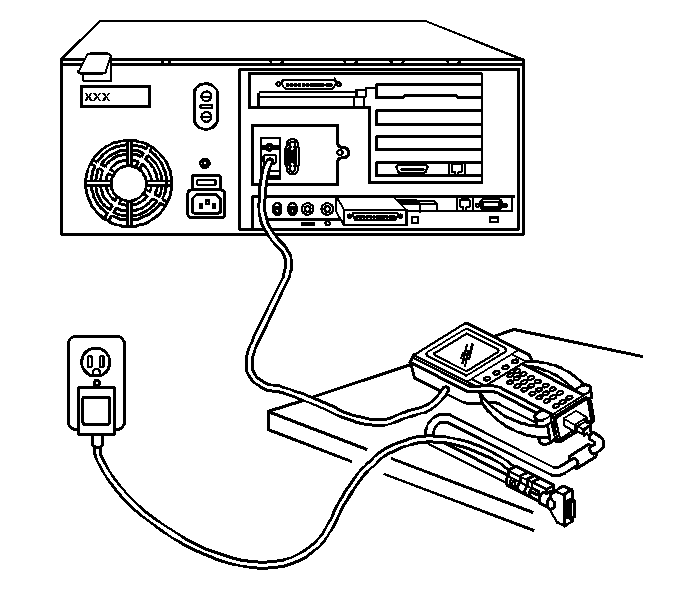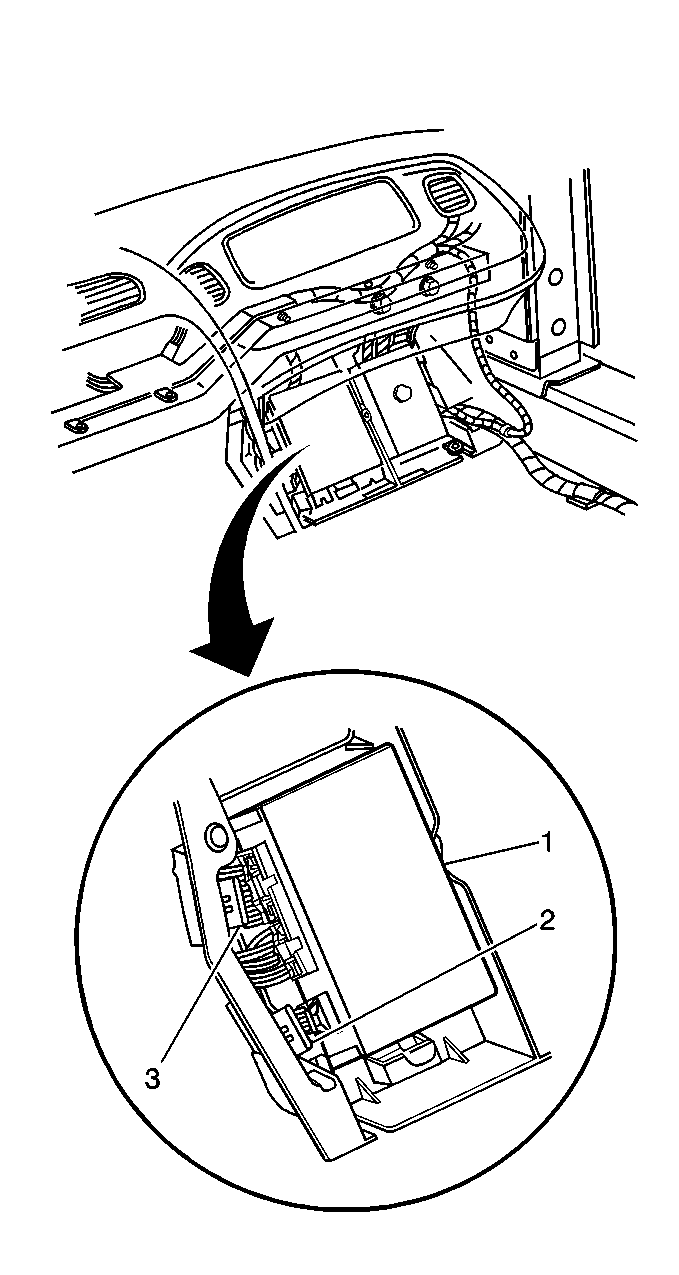Service Programming System (SPS) Pass-Thru Procedure
Pass-Thru programming allows the scan tool to remain connected to the terminal
and to the vehicle throughout the programming process. The vehicle must be in close
proximity to the terminal while using Pass-Thru.
Performing the Pass-Thru Procedure
Important: The TIS supports service programming with the Tech 2™ scan tool
only.
- Launch the TIS application at the terminal.
- Select the Service Programming System.
- Highlight the following information on the Select Diagnostic Tool Programming
Process screen:
| • | Select Diagnostic Tool--Select Pass-Thru |
| • | Select Programming Process--Identify whether an existing module is
being reprogrammed or a module is being replaced with a new one. |
| • | Select ECU Location--Select vehicle |
- Select Next.
- Complete all terminal-directed data on the Preparing for Communication/Determine
Vehicle screen until Next is highlighted.
Important: In order to reduce the potential for signal loss, the RS-232 cable should not
be more than 25 feet long.
- Select Next.
- Follow the instructions on the Preparing for Communication screen.
- Select Next.
Important: The correct vehicle identification number (VIN) must be entered if the VIN
does not appear correctly.
- Verify the VIN on the Validate Vehicle Identification Number screen.
- Select Next.
Important:
| • | When selecting the vehicle configuration index (VCI) programming type,
a valid VCI number for the vehicle must be entered. This number may be obtained from
the Techline Customer Support. |
| • | The correct tire size and axle ratio must be highlighted and a valid VCI
number entered if you select Reconfigure for your programming type. |
- If an option screen appears, verify the vehicle configuration and/or RPO information.
- Select Next.
- Highlight the appropriate control module and programming type on the Supported
Controllers screen.
- Select Next.
Important: Select Cancel if you receive a message stating that the calibration selected
is already the current calibration in the control module and reprogramming with the
same download is not allowed.
- Select the proper calibrations on the Calibration Selection screen.
- Ensure all the folder tabs have a green check mark.
- Select Next.
- Verify the current calibrations with the selected calibrations.
- Select Next.
- The Transfer Data screen will appear until the progress bar reaches 100 percent.
This may take up to 30 minutes.
- Complete all of the terminal-directed data on the Programming Complete
screen.
Important: Some vehicles will require that Idle Learn, Theft Deterrent Relearn, or Crankshaft
Variation Learn procedures be performed after programming. Consult the appropriate
service information for these procedures.
- Turn OFF the Tech 2™.
- Disconnect the Tech 2™ from the vehicle.
Service Programming System (SPS) Off Board Remote Procedure
Tools Required
J 41207-C Off-Board Programming
Adapter Kit
The J 41207-C
is required
when a module must be programmed without having the vehicle present. The adapter
allows the module to be turned ON and communicate with the scan tool.
For additional SPS information, refer to
Service Programming System (SPS) Description
.
Important: Ensure the Tech 2 and the terminal are both equipped with the latest
software before performing SPS.
Performing the Off Board Remote Procedure
- Obtain the vehicle identification number (VIN) of the vehicle for which
the module is being programmed.
Important: The TIS supports service programming with the Tech 2 scan tool only.
- Launch the TIS application at the terminal.
- Select the Service Programming System.
- Highlight the following information on the Select Diagnostic Tool and
Programming Process screen:
| • | Select Diagnostic Tool-Select Tech 2 |
| • | Select Programming Process-Identify whether an existing module is being
reprogrammed or replaced with a new one. |
| • | Select ECU location-select Off-Board Programming Adapter. |
- Select Next.

Important: Ensure the correct connector for the control module is used.
- Follow the directions on the Preparing for Communication screen for connecting
the following components:
| • | The Off-Board Programming Adapter (OBPA)--Refer to the TIS Users
Guide for a listing of the OBPA. |
- Select the Service Programming Request Information function on the Tech 2.
- Follow the Tech 2 instructions to obtain the module data and security
information.
- After the Tech 2 has received the data from the module, exit the
Request Info mode.
- Disconnect the Tech 2 from the OBPA.
- Turn OFF the Tech 2.

- Connect the Tech 2 to the terminal.
- Turn ON the Tech 2.
- Select Next at the terminal after the Tech 2 start-up screen appears.
- Enter the VIN of the vehicle that will be receiving the control module.
- Select Next.
Important: When selecting the vehicle configuration index (VCI) programming type, a valid
VCI number for the vehicle must be entered. This number may be obtained from Techline
Customer Support.
- Select the type of programming to be performed from the following categories:
| • | Normal--Used for updating an existing calibration or programming
a new controller. |
| • | Vehicle configuration index (VCI)--Used for updating an existing
controller or programming a new controller for newer vehicles whose VINs are not
yet in the database. |
| • | Reconfigure--Used to reconfigure a vehicle for changes in tire size
and axle ratios. |
- Select Next.
- Select a calibration on the Calibration Selection screen, if necessary.
- Ensure all the desired folder tabs have a green check mark.
- Select Next.
- Verify the current and the selected calibration of the control module
on the Summary screen.
- Select Next.
Important: Select Cancel if you receive a message stating that the calibration selected
is already the current calibration in the control module and reprogramming with
the same download is not allowed.
- Select OK.
- On model year 1996 and newer controllers, a crankshaft position (CKP)
relearn procedure box may appear. Select OK.
- Follow the on-screen instructions, if any, when the Program Controller/Programming
Complete screen appears.
- Select Close.
- Turn OFF the Tech 2.
- Disconnect the Tech 2 from the terminal.
- Connect the Tech 2 to the OBPA.
- Turn ON the Tech 2.
- Select Enter at the title screen.
- Select the Service Programming System at the Main Menu.
- Select the Program ECU function.
- Select Continue.
- Follow the on-screen instructions.
- Select Continue.
- Select Exit when the programming is complete.
- Turn OFF the OBPA.
- Turn OFF the Tech 2.
Important: Wait 30 seconds after the OBPA is turned OFF before disconnecting the
control module.
- Disconnect the OBPA from the Tech 2 and the control module.
Service Programming System (SPS) Off Board Pass-Thru Procedure
Tools Required
J 41207-C Off-Board Programming
Adapter Kit
The J 41207-C
is required
when a module must be programmed without having the vehicle present. The adapter allows
the module to be turned ON and communicate with the Tech 2.
For additional SPS information, refer to
Service Programming System (SPS) Description
.
Important: Ensure the Tech 2 and the terminal
are both equipped with the latest software before performing SPS.
Performing the Off Board Pass-Thru Procedure
Important: The TIS supports service programming with
the Tech 2 scan tool only.
- Launch the TIS application in the terminal.
- Select the Service Programming System.
- Highlight the following information on the Select Diagnostic Tool and
Programming Process Screen:
| • | Select Diagnostic Tool--Select Pass-Thru. |
| • | Select Programming Process--Identify whether an existing module is
being reprogrammed, or a module is being replaced with a new one. |
| • | Select ECU location--Select Off-Board Programming Adapter. |
- Select Next.

Important: In order to reduce the potential for signal
loss, the RS-232 cable should NOT be more than 25 feet long.
- Complete all terminal-directed data at the Preparing for Communication/Determine
Vehicle screen until Next is highlighted.
- Select Next.
Important: Ensure the correct connector for the control
module is used.
- Follow the on-screen instructions for connecting the following components:
| • | The Off-Board Programming Adapter (OBPA)--Refer to the TIS Users
Guide for a listing of OBPA. |
- Select Next.
- Pass-Thru displays the VIN stored in the control module. If a new control
module is being programmed, enter the correct VIN of the vehicle.
- Select Next.
- Select the appropriate options if the Options screen appears.
- Select Next.
Important: When selecting the vehicle configuration
index (VCI) programming type, a valid VCI number for the vehicle must be entered.
This number may be obtained from Techline Customer Support.
- Select the type of programming to be performed from the following categories:
| • | Normal--Used for updating an existing calibration or programming
a new controller. |
| • | Vehicle configuration index (VCI)--Used for updating an existing
controller or programming a new controller for newer vehicles whose VINs are not yet
in the database. |
| • | Reconfigure--Used to reconfigure a vehicle for changes in tire size
and axle ratios. |
- Select Next.
- Select a calibration selection on the Calibration Selection screen, if
necessary.
- Ensure all the desired calibration folder tabs have a green check mark.
- Select Next.
- Verify the current and selected calibration of the control module on the
Summary screen.
- Select Next.
Important: Select Cancel if you receive a message stating
that the calibration selected is already the current calibration in the control module
and reprogramming with the same download is not allowed.
- Select OK.
Important: On model year 1996 and newer controllers,
a crankshaft position (CKP) relearn procedure box may appear.
- Select OK.
- When programming is complete, a Program Controller/Programming Complete
screen appears. Follow the on-screen instructions, if any.
- Select Close.
- Turn OFF the OBPA.
- Turn OFF the scan tool.
Important: Wait 30 seconds after the OBPA is
shut OFF before disconnecting the control module.
- Disconnect the OBPA from the Tech 2 and the control module.
Service Programming System (SPS) On Board / Remote Procedure
Before Programming a Control Module
Important: Do NOT program a control module unless you are directed by a service procedure
or you are directed by a General Motors Corporation service bulletin. Programming
a control module at any other time will not permanently correct a customer's concern.
Ensure the following conditions are met before programming a control module:
| - | There is not a charging system concern. All charging system concerns
must be repaired before programming a control module. |
| - | The battery voltage is greater than 12 volts but less than 16 volts.
The battery must be charged before programming the control module if the battery
voltage is low. |
| - | A battery charger is NOT connected to the vehicle's battery. Incorrect
system voltage or voltage fluctuations from a battery charger, may cause programming
failure or control module damage. |
| - | Turn OFF or disable any system that may put a load on the vehicle's battery: |
| • | The daytime running lights (DRL)--Applying the parking brake, on
most vehicles, disables the DRL system. Refer to the Owners manual. |
| • | The engine cooling fans |
| • | The ignition switch is in the proper position. The scan tool prompts you
to turn ON the ignition, with the engine OFF. Do NOT change the position of the
ignition switch during the programming procedure unless instructed to do so. |
| • | Secure all tool connections: |
| - | The connection at the DLC is secure. |
| - | The voltage supply circuits |
| • | DO NOT disturb the tool harnesses while programming. If an interruption
occurs during the programming procedure, programming failure or control module
damage may occur. |
PCM Programming Set Up with Special Tool
Notice: The PCM will be damaged if proper programming procedures are not followed.
- Ensure that the following conditions have been met:
| • | The battery is fully charged. |
| • | The scan tool cable connection at the data link connector (DLC) is secure. |
- Turn OFF the ignition.
- Remove the passenger side floor access panel. Refer to
Front Floor Kick-Up Panel Replacement
in Interior Trim.

- Remove the splice pack/star connector shorting
bars from both splice pack/star connectors (2, 3). It may be necessary to
remove splice pack/star connectors from the mounting positions.
- Install the star connector cable #1 from the J 42236
Serial Data Link Tester to the 12 pin
splice pack/star (3). This is the connector with 8 or 10 wires.
- Install the star connector cable #2 from the J 42236
to the 12 pin splice pack/star (2).
This is the connector with 4 wires.
- Select the star connector cable #1 on the J 42236
toggle switch.
- Select position B on the J 42236
.
Remote Programming
- Turn ON the ignition, with the engine OFF.
- Turn OFF all vehicle accessories.
- With the Tech 2, select Service Programming.
- Identify vehicle information as requested by the Tech 2.
- Verify the displayed VIN with the vehicles VIN. If the displayed VIN does
not match the actual VIN, write down the actual VIN and correct the VIN at the Techline
terminal.
- When complete, exit Service Programming.
- Turn OFF the Tech 2 and disconnect the Tech 2 from the vehicle.
- Turn OFF the ignition.
- Connect the Tech 2 to the Techline terminal.
- Select Service Programming.
- Select Tech 2 as the tool you are using.
- Select the type of programming to be performed.
- Verify the displayed VIN with the vehicles VIN. Correct the VIN as necessary.
- Select the type of module you are programming.
- Identify the type of programming that you are performing.
| • | Normal--This type of programming is for updating an existing calibration
or programming a new controller. |
| • | Vehicle Configuration Index (VCI)--This selection is used if the
vehicle VIN is unavailable or not recognized by the Techline terminal. Observe,
you will need to contact the Techline Customer Support center to use this option. |
| • | Reconfigure--This is to reconfigure a vehicle, such as tire size
and axle ratio changes. |
- Select the appropriate calibration file.
- Ensure all connections are secure.
- Select Reprog in order to initiate the download of the new calibration
to the Tech 2.
- After the download is complete, turn OFF the Tech 2.
- Disconnect the Tech 2 from the Techline terminal.
- Install the Tech 2 to the data link connector (DLC).
- Turn ON the Tech 2.
- Turn ON the ignition, with the engine OFF.
- Select Service Programming.
Important: DO NOT turn OFF the ignition if the programming procedure is interrupted or
unsuccessful. Ensure that all the PCM and DLC connections are secure and the Techline
operating software is up to date. Attempt to reprogram the control module. If the
control module cannot be programmed, replace the control module. Refer to
Powertrain Control Module Replacement
.
- Select Program.
- After the download is complete, EXIT Service Programming.
- Turn OFF the ignition for 30 seconds.
- Turn OFF the Tech 2.
- If a control module is replaced the following service procedures must
be performed:
Programming Verification
- With a scan tool, clear the DTCs.
- Attempt to start the engine.
- Repeat the service programming procedure if the engine does not start
or operates poorly. Perform the following procedures before programming the PCM:
| • | Ensure the control module and DLC connections are OK. |
| • | Ensure the Techline operating software is up to date. |
| • | Ensure the calibration part number is correct for the vehicle. |
- Attempt to program the control module. If the control module still cannot
be programmed properly, replace the control module. Refer to
Powertrain Control Module Replacement
.




